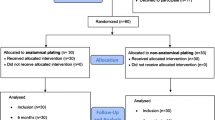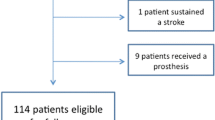Abstract
Purpose
Surgical treatment of three or four part fractures of the proximal humerus is complex. Different conservative techniques have been described. The main goal of this study was to compare the clinical and radiological outcomes of Bilboquet and locking plate at two year follow-up.
Methods
This is a retrospective, comparative study, with a continuous series of 41 patients. Bony fixation was achieved with a Bilboquet device in 22 patients or a locking plate in 19 patients. Patient evaluation included clinical data: shoulder range of motion, Constant–Murley shoulder score and DASH (Disabilities of the Arm, Shoulder and Hand) score, and imaging using standard shoulder X-rays.
Results
Of the 41 patients included, 1 patient was lost to follow-up in the locking plate group. At a mean follow-up of 24 months patients in Bilboquet group showed a Constant score higher than in locking plate (p = 0.02). Range of motion and DASH score were not significantly different between the two groups. avascular necrosis occured in three patients of Bilboquet group (14%) versus in two patients in the locking plate group (11%) (p > 0.5). Complication and reintervention rate were non-significantly higher in the locking plate group than in the Bilboquet group (37 vs 14%).
Conclusion
Bilboquet and locking plate give good functional outcomes in complex proximal humerus fractures. However, the Bilboquet device appears to provide better functional results than locking plate at mid-term follow-up.






Similar content being viewed by others
References
Lanting B, MacDermid J, Drosdowech D, Faber KJ (2008) Proximal humeral fractures : A systematic review of treatment modalities. J Shoulder Elb Surg 17(1):42–54. https://doi.org/10.1016/j.jse.2007.03.016
Stableforth PG (1984) Four-part fractures of the neck of the humerus. The Journal of Bone and Joint Surgery. Br Vol 66(1):104–108
Akalın Y, Şahin İG, Çevik N, Güler BO, Avci Ö, Öztürk A (2020) Locking compression plate fixation versus intramedullary nailing of humeral shaft fractures: Which one is better? A single-centre prospective randomized study. Int Orthop. https://doi.org/10.1007/s00264-020-04696-6
Doursounian L, Grimberg J, Cazeau C, Jos E, Touzard RC (2000) A new internal fixation technique for fractures of the proximal humerus--the Bilboquet device : A report on 26 cases. J Shoulder Elb Surg 9(4):279–288. https://doi.org/10.1067/mse.2000.106086
Nowak LL, Dehghan N, McKee MD, Schemitsch EH (2018) Plate fixation for management of humerus fractures. Injury 49(Suppl 1):S33–S38. https://doi.org/10.1016/S0020-1383(18)30300-0
Thanasas C, Kontakis G, Angoules A, Limb D, Giannoudis P (2009) Treatment of proximal humerus fractures with locking plates: a systematic review. J Shoulder Elb Surg 18(6):837–844
Doursounian L, Kilinc A, Cherrier B, Nourissat G (2011) Complex proximal humeral fractures : A prospective study of 22 cases treated using the « Bilboquet » device. Orthop Traumatol Surg Res: OTSR 97(1):58–66. https://doi.org/10.1016/j.otsr.2010.06.015
Doursounian L, Le Sant A, Mauprivez R, Miquel A, Beauthier-Landauer V (2016) Open reduction and internal fixation of three- and four-part proximal humeral fractures by intra-focal distraction : Observational study of twenty five cases. Int Orthop 40(11):2373–2382. https://doi.org/10.1007/s00264-015-3109-8
Neer CS (2002) Four-segment classification of proximal humeral fractures : Purpose and reliable use. J Shoulder Elb Surg 11(4):389–400. https://doi.org/10.1067/mse.2002.124346
Constant CR, Murley AH (1987) A clinical method of functional assessment of the shoulder. Clin Orthop Relat Res 214:160–164
Hudak PL, Amadio PC, Bombardier C (1996) Development of an upper extremity outcome measure : The DASH (disabilities of the arm, shoulder and hand) [corrected]. The Upper Extremity Collaborative Group (UECG). Am J Ind Med 29(6):602–608. https://doi.org/10.1002/(SICI)1097-0274(199606)29:6<602::AID-AJIM4>3.0.CO;2-L
Maier D, Jaeger M, Izadpanah K, Strohm PC, Suedkamp NP (2014) Proximal humeral fracture treatment in adults. The Journal of Bone and Joint Surgery. Am Vol 96(3):251–261. https://doi.org/10.2106/JBJS.L.01293
Soliman OA, Koptan WMT (2013) Four-part fracture dislocations of the proximal humerus in young adults : Results of fixation. Injury 44(4):442–447. https://doi.org/10.1016/j.injury.2012.09.005
Chen L, Xing F, Xiang Z (2016) Effectiveness and safety of interventions for treating adults with displaced proximal humeral fracture : A Network Meta-Analysis and Systematic Review. PLoS One 11(11):e0166801. https://doi.org/10.1371/journal.pone.0166801
Roberson TA, Bentley JC, Griscom JT, Kissenberth MJ, Tolan SJ, Hawkins RJ, Tokish JM (2017) Outcomes of total shoulder arthroplasty in patients younger than 65 years : A systematic review. J Shoulder Elb Surg 26(7):1298–1306. https://doi.org/10.1016/j.jse.2016.12.069
Valenti P, Zampeli F, Ciais G, Kany J, Katz D (2020) The initial treatment of complex proximal humerus fracture affects the outcome of revision with reverse shoulder arthroplasty. Int Orthop 44(7):1331–1340. https://doi.org/10.1007/s00264-020-04612-y
Sun Q, Wu X, Wang L, Cai M (2020) The plate fixation strategy of complex proximal humeral fractures. Int Orthop. https://doi.org/10.1007/s00264-020-04544-7
Südkamp N, Bayer J, Hepp P, Voigt C, Oestern H, Kääb M, Luo C, Plecko M, Wendt K, Köstler W, Konrad G (2009) Open reduction and internal fixation of proximal humeral fractures with use of the locking proximal humerus plate. Results of a prospective, multicenter, observational study. J Bone Joint Surg Am 91(6):1320–1328. https://doi.org/10.2106/JBJS.H.00006
Brunner F, Sommer C, Bahrs C, Heuwinkel R, Hafner C, Rillmann P, Kohut G, Ekelund A, Muller M, Audigé L, Babst R (2009) Open reduction and internal fixation of proximal humerus fractures using a proximal humeral locked plate : A prospective multicenter analysis. J Orthop Trauma 23(3):163–172. https://doi.org/10.1097/BOT.0b013e3181920e5b
Hirschmann MT, Fallegger B, Amsler F, Regazzoni P, Gross T (2011) Clinical longer-term results after internal fixation of proximal humerus fractures with a locking compression plate (PHILOS). J Orthop Trauma 25(5):286–293. https://doi.org/10.1097/BOT.0b013e3181f2b20e
Erasmo R, Guerra G, Guerra L (2014) Fractures and fracture-dislocations of the proximal humerus : A retrospective analysis of 82 cases treated with the Philos(®) locking plate. Injury 45(Suppl 6):S43–S48. https://doi.org/10.1016/j.injury.2014.10.022
Hertel R, Hempfing A, Stiehler M, Leunig M (2004) Predictors of humeral head ischemia after intracapsular fracture of the proximal humerus. J Shoulder Elb Surg 13(4):427–433. https://doi.org/10.1016/j.jse.2004.01.034
Availability of data and materials
The datasets generated during and/or analysed during the current study are available from the corresponding author on reasonable request.
Funding
No funding was received to assist with the preparation of this manuscript.
Author information
Authors and Affiliations
Contributions
All authors contributed to the study conception and design. Material preparation, data collection, and analysis were performed by Yaniv Bismuth, Adeline Cambon-Binder, Alain Sautet, Levon Doursounian, and Thomas Gregory. The first draft of the manuscript was written by Claire Bastard, and all authors commented on previous versions of the manuscript. All authors read and approved the final manuscript.
Corresponding author
Ethics declarations
Conflicts of interest
We declare that we have no conflicts of interest in the authorship or publication of this contribution.
Ethical approval
This retrospective chart review study involving human participants was in accordance with the ethical standards of the institutional and national research committee and with the 1964 Helsinki Declaration and its later amendments or comparable ethical standards.
Consent to participate
Informed consent was obtained from all individual participants included in the study.
Consent to publish
Patients signed informed consent regarding publishing their data and photographs.
Additional information
Publisher’s note
Springer Nature remains neutral with regard to jurisdictional claims in published maps and institutional affiliations.
Level of evidence: IV
Rights and permissions
About this article
Cite this article
Bismuth, Y., Cambon-Binder, A., Sautet, A. et al. Comparison of “Bilboquet” device and locking plate for surgical treatment of proximal humerus complex fractures at two years follow-up. International Orthopaedics (SICOT) 45, 1811–1816 (2021). https://doi.org/10.1007/s00264-021-04967-w
Received:
Accepted:
Published:
Issue Date:
DOI: https://doi.org/10.1007/s00264-021-04967-w




